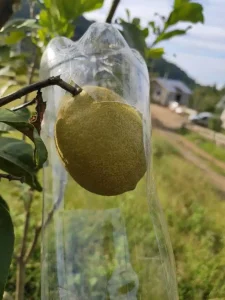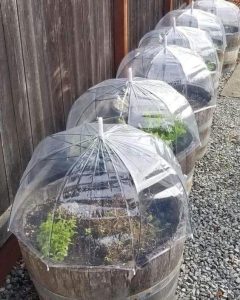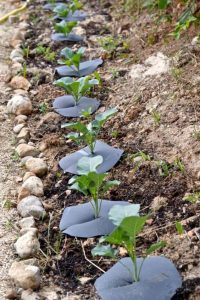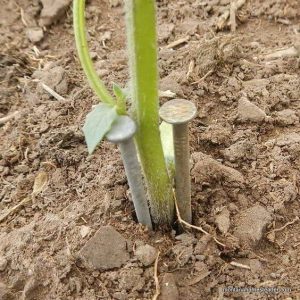
It is a simple and DIY (do-it-yourself) tool used for harvesting fruits from trees, especially those that are out of reach. It is made by attaching a plastic bottle to the end of a long pole or stick, creating a makeshift basket or receptacle to collect fruit.
It’s a useful tool for home gardeners and can help reduce the risk of injury from climbing trees or using ladders to reach high branches. Additionally, it allows you to collect fruit gently to avoid bruising or damaging the produce.
Materials needed: A plastic bottle with a screw-on cap (2-liter or similar size), a sturdy wooden or metal pole (approximately 4-6 feet long), a sharp knife or scissors, a screwdriver or drill, strong adhesive or epoxy (optional).
How to make:
- Step 1: Using a sharp knife or scissors, carefully cut a hole near the top of the plastic bottle, leaving enough space to insert the pole through. Make sure the hole is large enough to fit the pole snugly.
- Step 2: Attach the bottle to the pole, and insert the pole through the hole in the plastic bottle. The bottle should slide down the pole, with the cap end facing upward. If the bottle is loose on the pole, you can use strong adhesive or epoxy to secure it in place, ensuring it won’t slide off during use.
To use your plastic bottle fruit picker, simply position the bottle beneath a fruit on a high branch. Reach up and gently twist or tap the fruit with the bottle’s opening, causing it to drop into the bottle.
5. Seed Starting in Mini Greenhouses

Creating mini greenhouses is a practical way to protect young vegetables from harsh weather conditions. They also known as seedling trays or seed starting trays with transparent lids, create a controlled environment that encourages seed germination and early seedling growth. It allows you to control the early stages of plant growth and extend your growing season.
Materials needed: Small steel frames (shaped like small umbrellas), nylons or clear plastic sheeting, garden stakes or small wooden stakes, twine, or zip ties.
How to make:
- Step 1: Place the steel frames over the young vegetables you want to protect. Make sure the frames provide enough space and height for the vegetables to grow within.
- Step 2: Use garden stakes or small wooden stakes to secure the steel frames in the ground. Position the stakes around the perimeter of each frame and drive them firmly into the soil to prevent the frames from shifting or falling over.
- Step 3: Cover with nylons, drape nylons, or clear plastic sheeting over the steel frames to create a transparent enclosure. Ensure that the material completely covers the frames and reaches the ground on all sides.
- Step 4: Secure the covering by using twine or zip ties to secure the nylon or plastic sheeting to the steel frames. Make sure the covering is taut and snugly attached to the frames to prevent it from blowing away in the wind.
To provide ventilation and access to your plants, you can partially open or lift the covering during the day when the weather is mild. In the evening or during adverse conditions, close the covering to protect the plants.
6. Natural Garden Pest Control

In some cases, cabbages look so mighty strong, but there is a cabbage fly that can easily destroy all your crops. That is the reason why it’s advised that you put insect nets around the cabbages and some collars around their stem. You can make these collars from some old thick plastic mixed with fabric sheets. Besides, you can make them from just about anything that’s a bit thick and will keep in place and will be able to face rain showers and wind.
It’s very simple to make, you cut a circle from some sturdy material, and you cut the circle through halfway. When you reach the middle, you start cutting some small cuts in a circle shape. You do this so that the cabbage can grow during the period that the collar is still on, but at the same time, it will keep the collar closed off against the egg-laying flies during periods when the stem is still thin. After you have placed them around the stem, you should press them onto the soil firmly so that there is no air between the collar and the cabbage.
This method manages and reduces pests in your garden without relying on synthetic chemicals. It is not only safer for the environment and beneficial insects but also promotes healthier and more sustainable gardening practices.
7. Way to Get Rid of Cutworms

Cutworms are common garden pests that can damage or kill young seedlings and transplants by chewing through their stems at or near ground level. These caterpillars are active at night and can be a frustrating problem for gardeners. So, to organically protect garden plants from cutworms, here is one of the easiest and most effective ways to get rid of them.
For larger plant starts, like tomatoes and tomatillos, you can use nails for stem protectors. In addition, you also use toothpicks or plastic drinking straws cut into shorter pieces. Basically, the idea is to put something tall around the stem of the plant to prevent the cutworm from wrapping around and cutting it.









